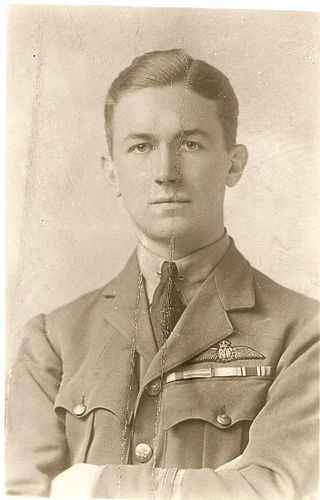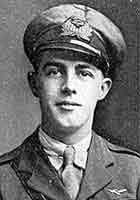
Robert Alexander Little,, a World War I fighter pilot, is generally regarded as the most successful Australian flying ace, with an official tally of forty-seven victories. Born in Victoria, he travelled to England in 1915 and learned to fly at his own expense before joining the Royal Naval Air Service (RNAS). Posted to the Western Front in June 1916, he flew Sopwith Pups, Triplanes and Camels with No. 8 Squadron RNAS, achieving thirty-eight victories within a year and earning the Distinguished Service Order and Bar, the Distinguished Service Cross and Bar, and the French Croix de guerre. Rested in July 1917, he volunteered to return to the front in March 1918 and scored a further nine victories with No. 3 Squadron RNAS before he was killed in action on the night of 27 May, aged twenty-two.

Richard Pearman Minifie, was an Australian fighter pilot and flying ace of the First World War. Born in Victoria, he attended Melbourne Church of England Grammar School. Travelling to the United Kingdom, he enlisted in the Royal Naval Air Service in June 1916. Accepted for flight training, he completed his instruction in December and joined No. 1 (Naval) Squadron RNAS on the Western Front in January 1917, flying Sopwith Triplanes. He went on to score seventeen aerial victories on this type of machine throughout the year, becoming both the youngest Australian flying ace of the First World War and No. 1 (Naval) Squadron's highest-scoring ace on the Triplane. The unit re-equipped with the Sopwith Camel late in 1917, with Minifie going on to achieve a further four victories on the aircraft, raising his final tally to a score of twenty-one aircraft shot down.
Captain William Lancelot Jordan DSC & Bar, DFC was a South African World War I flying ace credited with 39 victories.
Joseph Stewart Temple Fall, was a Canadian aviator, military officer, and First World War flying ace credited with 36 aerial victories.

Arthur Treloar Whealy DSC & Bar DFC was a Canadian First World War flying ace, officially credited with 27 victories.

Major Charles Dawson Booker was an English World War I fighter ace credited with 29 victories. He was promoted to high rank while relatively young as a result of his gallantry and unswerving dedication to his country.
Flight Commander Frederick Carr Armstrong was a Canadian First World War flying ace, officially credited with 13 aerial victories.
Captain Ronald McNeill Keirstead DSC was a Canadian First World War flying ace, officially credited with 13 victories.
Captain John Gerald Manuel was a Canadian First World War flying ace, officially credited with 13 victories. He was the son of George Morton and Edith Juliet Paget Manuel.
Captain George Edwin Thomson DSO MC was a Scottish World War I flying ace credited with 21 aerial victories. He was the second ranking ace of his squadron, and one of the leading Sopwith Camel aces.

Captain Albert James Enstone was a British World War I flying ace. Various sources credit him with differing air victory scores. In one text, he is credited with 13 confirmed aerial victories and driving down 11 other German aircraft, including three Gotha bombers. Another source claims 15 confirmed aerial victories; ten were destroyed, and five were driven down out of control. He is known to have attacked two Gotha bombers. Regardless of his actual victory totals, records show that Enstone served his country valiantly.
Captain Harold Thomas Mellings was a British World War I flying ace credited with 15 aerial victories.
Flight Commander Guy William Price was an Irish Royal Naval Air Service flying ace during World War I, having 12 confirmed aerial victories. He was awarded the Distinguished Service Cross twice within a 22-day period.

Flight Sub-Lieutenant Harold Day was a Welsh World War I flying ace credited with 11 confirmed aerial victories.
Flight Commander Arnold Jacques Chadwick was a Canadian-born World War I flying ace credited with 11 aerial victories. He became an ace twice over; once while flying Sopwith Pups and again while piloting Sopwith Camels.
Lieutenant Clement Wattson Payton was an English World War I flying ace credited with 11 official victories.
Oberleutnant Walter Ewers was a World War I flying ace credited with eight aerial victories.
Merrill Samuel Taylor was a Canadian flying ace of the First World War. He was credited with seven aerial victories while flying a Sopwith Camel fighter for the Royal Naval Air Service and, later, the Royal Air Force. He touched off the air battle that resulted in the death of the war's leading ace, Manfred von Richthofen, on 21 April 1918. On 2 May 1918, he killed German ace Hans Weiss for his fifth victory. Taylor was killed in action by Franz Büchner on 7 July 1918.

Lieutenant Pruett Mullens Dennett was a World War I British flying ace. He was credited with ten aerial victories, the last occurring on the day he was killed in combat.
Lieutenant Harold Francis Stackard was a First World War British flying ace credited with fifteen aerial victories. In addition to serving as a pilot during the war, he was a Royal Air Force instructor.




